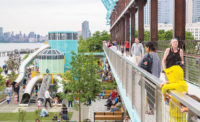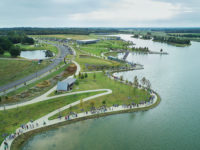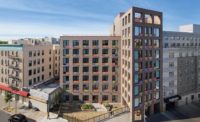London
In the streets of Fitzrovia, in central London, the locally based architecture firm DSDHA has created an intriguing introduction to this urban neighborhood. As its name suggests, the Corner House sits smartly at the junction of the foodie haven Charlotte Street and tranquil Tottenham Street, a stone’s throw from bustling Oxford Circus. Among a hodgepodge of 18th-century houses with narrow frontages, postwar industrial buildings, and glossy contemporary offices, the Corner House succeeds in discovering freshness solidly rooted in timelessness.
DSDHA had previously collaborated with the client, Derwent London, on its growing portfolio of property in the Fitzrovia area. The architects’ past projects, from schools to residential buildings, have demonstrated their flair for functionality. Corner House, an apartment building, goes more deeply into the crafting of each interior space, resulting in a discreet architecture of quality and elegance.
In the face of skyrocketing rents in the capital and a deficiency of new social housing, local planning authorities offer incentives to developers to build affordable housing, requiring a certain number of such units in large developments. Camden Council, the authority overseeing the site of Corner House, was particularly eager to encourage the building of these units, which are sold or rented with government subsidies. DSDHA’s six-story building incorporates two of these affordable-housing units as well as nine market-rate apartments, including a luxurious penthouse, and commercial space on the ground floor.
Corner House is a building with three subtly different facades—the main ones on Charlotte and Tottenham Streets, and a third on the tiny Tottenham Mews—each presentation of the building a variation on a refined material language. The tone of brick and proportional massing changes to reestablish the three historical addresses on the site and create three separate entrances to the building: a commercial entrance and separate entries for the market-rate and affordable housing. This allows the building to escape the feel of a large combined city block while trying to avoid the politically charged “poor door” by presenting the respective doors on different elevations of the building.
What is striking at street level is the architects’ attention to detail and craft. Tom Greenall, associate director at DSDHA, describes how Derwent London was keen to use brick to give the building a “resolutely residential” character, in contrast with glazed, more corporate developments. After deep analysis of Fitzrovia’s modern and historical facades, a dark charcoal and light gray brick were chosen. The practice collaborated with Petersen, a Danish brick company well known for its handmade and “water-struck” bricks, which give each masonry unit an individual character and irregularity. DSDHA used these bricks to create a load-bearing structure with traditional lime mortar, in harmony with its historical context. Although this required intense craftsmanship and longer construction times, it minimizes the building’s concrete frame and foundations, as well as reducing the need for complex movement joints.
The translation of formal 18th-century facades into this contemporary counterpart is handled with grace and originality. The brickwork is stepped to form asymmetric reveals, with a subtle hierarchy of sizes between each row of openings. The top-floor windows are angled inward to create a shifted and distorted reflection from the exterior, adding to the details that make this facade striking while exercising restraint.
DSDHA’s attention to openings and admission of light is central to making the interiors welcoming. The internal planning provides every apartment with windows on two or more elevations, and the building nimbly negotiates the requirements of surrounding buildings’ right to light under London’s building code.
The crowning jewels of the Corner House are two faceted pavilions for the top-floor penthouse, which nestle into the city’s roofscape. Using the envelope established by right to light, the pavilions open up seductive spaces in a modern “attic.” These more contemporary features are also intensely hand-crafted. Custom-made scored zinc cassettes are fitted together to form each facet, allowing rainwater to drain behind the roof surface and obviating the need for any visible gutters.
The architects also designed metal railings and decorative grilles, giving the exterior a subtle opulence, with echoes of its historical context. This language of dark metal continues into the interiors and common spaces of the building. The triumphant feature is the metal staircase, carefully positioned to be directly in view as soon as you enter the main residential door. The staircase was made in small sections and welded on-site, to achieve an illusion that the stairs have been folded from a continuous sheet of metal. A process of hand-bending and hand-rolling the metal was used to create a balustrade with swan-neck junctions. It is at these points that the practice has shown its willingness to invest in details to create a richer whole.
The Corner House sets a high bar for a contemporary intervention into a complex historical site. Affordable units are typically rather standardized; DSDHA’s intelligent and innovative integration of lower-cost units into this building leads the way for higher-quality, bespoke subsidized housing in central London. DSDHA has created a persuasive balance of affordable and luxury, past and present, solidity and elegance, to create a quietly alluring building.
PeopleArchitect: DSDHA — Deborah Saunt, Tom Greenall, Matthew Lambert, Arnold Seligmann, Deb Adams, Natasha Reid, Luke Jackson, Jeremy Corminboeuf, Marine Fleury, Marianna Filippou Engineers: Elliott Wood (structural); GDM Partnership (services) Consultants Core Five (quality surveyor); Gardiner & Theobald (project management); BWC Fire (fire) General contractor: Knight Harwood Client: Derwent London Size: 19,400 square feet Cost: withheld Completion date: October 2015
|
ProductsMasonry Petersen Metal panels Rheinzink Timber Flooring Dinesen Windows Schüco |

















Post a comment to this article
Report Abusive Comment